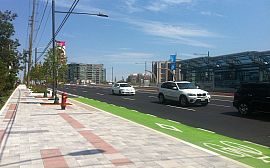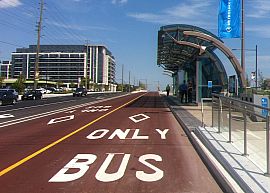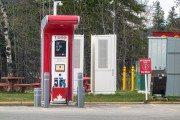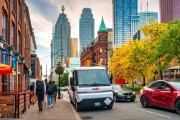When I was growing up at Highway 7 and Bayview Avenue in Markham, the bus showed up when it felt like it. An hour could pass while you waited at the stop.
This Sunday, I ventured back to my homeland and did something I never would have considered as a teenager: I chose to ride the bus along Highway 7. But this was no ordinary bus.
The first completed section of Highway 7’s new Viva bus rapid transit (BRT) line opened on Sunday. It features separated lanes with their own traffic signals, so the buses don’t run in traffic. Thanks to these features, the BRT can run at speeds approaching those of light rail transit (LRT).
In fact, BRT and LRT are very similar in terms of the service provided to riders. Because there’s no need for track construction, BRT has lower capital costs — often half as much per kilometre as LRT — and quicker construction times. The Highway 7 BRT, part of Metrolinx’s Big Move plan, will take about three years from shovel to ride. The section that opened this weekend was built in just two years — on budget and four months ahead of schedule.
When fully implemented, the average waiting time for the Viva BRT will be two to five minutes — the service is reliable, frequent and immune to traffic jams. Passengers board the bus at swanky stations with automated ticket machines for all-door boarding, which means no line-ups of people waiting to pay the driver (think of boarding Vancouver’s SkyTrain).
It's about density
I’m a fan of Toronto’s subways and proposed light rail, and have studied which transit options are most cost-effective and appropriate for different neighbourhoods given their design and population density.

Subways make sense downtown, where the level of ridership can support both construction and operation costs, and where population density is high enough to attract and maintain businesses.
However, subways in low-density neighbourhoods can sometimes fail to improve economic development, in part because underground transit moves people away from street level businesses that already have lower levels of pedestrian traffic. In the case of the eastern reaches of the Bloor-Danforth line, the subway negatively impacted businesses and street-level vibrancy for decades. Without strong policies that support compact and mixed-use development, the same pattern will continue along the north-western stretch of the Yonge-University line.
BRT and LRT have a proven capacity to revitalize neighbourhoods. By keeping riders at street level, they create an active, commerce-friendly streetscape, rather than forcing commuters and shoppers underground. The Viva BRT can help transform the neighbourhood by supporting the growth of businesses and compact, pedestrian-friendly developments that are integrated into the surrounding area.
![*Appropriate population density for LRT and subways in Toronto. Source: [<i>Making Tracks,</i>;http://www.pembina.org/pub/2151] The Pembina Institute, 2011. Table of transit density data](/images/blogs/full/transit-density-table.png)
Light rail can carry more passengers than BRT, so it makes sense for corridors like Finch Avenue and Sheppard Avenue that have much higher ridership than those in Markham. The Finch bus is currently running at capacity; replacing it with LRT will be faster than building a subway and better suited to the corridor’s level of density. Finch Avenue would also benefit from the economic revitalization that street-level rapid transit brings.
Busways, busways, busways!
The capacity of rapid buses is also a perfect match for lower-density neighbourhoods. The Viva BRT is both community and commuter-friendly: it will service local built-up areas of Markham, while eventually linking with the extended subway to take passengers downtown.
Rapid buses are also a smart purchase for suburban municipalities, particularly when current or projected ridership levels may not justify the cost of LRT or other fixed rail services. Unlike those options, BRT can be built incrementally as ridership grows and revenue is raised. The operating costs are lower than for a conventional bus, and the implementation of BRTs can be customized for each community.

York Region Transit and Metrolinx are building 32.4 kilometres of separated busways for the Viva BRT, and if the completed stretch along Highway 7 is setting the standard, we can expect ridership to increase. The buses are state-of-the-art and the ride is a pleasure, especially when you’re zooming past cars stuck in traffic.
Critics of both BRT and LRT should ride the new Viva bus to understand the benefits of surface right-of-way rapid transit. The Big Move is creating a network of BRT, LRT and subways for the Greater Toronto and Hamilton Area. This is the ride of the future, both for commuters and for communities.
Follow Cherise on Twitter @CheriseBurda.






